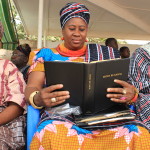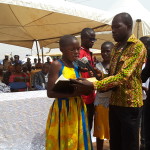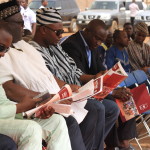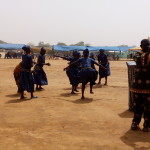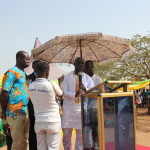Complete Bibles in Kasem, Gonja, Kusaal, Nafaanra, and Dega were dedicated between November 2015 and March 2016. Never before in the fifty – four (54) year history of GILLBT, and in the history of Ghana, have so many Bibles been launched in so short a period. This brings to the total 14 Full (Old Testament + New Testament) Bibles, and 29 New Testaments completed by GILLBT in Ghanaian languages.
Through this output, Ghana is the African country that has made the most contributions to the pool of translated Bibles worldwide in the Wycliffe family. As an organization established to develop the languages of Ghana, promote literacy in these languages, and translate the Bible into these Ghanaian languages, we are grateful to God for this enablement.
As is our tradition, we dedicated these Bibles in the respective language communities: Kasem (Nov 8, 13 and 14 2015 in Kumasi, Chiana and Navrongo, respectively); Gonja (February 6 at Buipe); Kusaal (February 20 at Bawku); Nafaanra (March 5 at Banda Ahenkro); and, Dega (March 18 at New Longoro).
The joy of a language group hearing God speak in their heart language was visibly expressed on the faces of these people who for the first time read their mother tongue Bible.
KASEM
Years of painstaking work in language development, literacy and Bible translation by selfless people who began, supported and completed the work we celebrate today can only be rewarded by God. The Kasem Bible has been the work of many people over many years. The beginning can be traced back to work done by the Catholic fathers as far back as 1933. Dr John Kathleen Callow (Ada and Kada) started to learn Kasem in 1962, followed by Philip and Judy Hewer (Adoa & Kadoa) in 1972. Work on the Old Testament started in 1999, led by Rev. Jonah Kwotua. There was input from leaders of various churches as well as advice of academics such as Prof A. K Awedoba (Institute of African Studies, Legon) especially with regards to spelling and writing of Kasem.
- Copies of the Kasem Bible exhibited
- Dancers leading a procession to the Dedication grounds in Kumasi
- Excited Kasena natives at the Dedication in Kumasi
- Philip Hewer and some church leaders dedicating the Kasem Bible in Chiana
- Purchasing her copy
- Reading her first Kasem Bible
GONJA
WEC missionaries entered Ghana in 1940 and assumed responsibility for the Gonja area of the Northern Region. Mission stations and churches were established at Tuna, Damongo, Kpandai, Oti River, and the surrounding areas. Response to the gospel first came from other tribal groups who settled on Gonja land, and who were less influenced by Islam than the Gonjas’. In 1969 Jeanette Zwart, a WEC missionary, in response to the challenge of reaching Gonjas for Christ commenced Bible Translation in Gonja, assisted by John Kipo Mahamah, one of the first Gonja Christians. The New Testament was completed and dedicated in 1983.
After this WEC pulled out of Gonja. Several years later the need of having the Old Testament also translated into Gonja became inevitable. The challenge was thrown to Gonja Christains. This led to a meeting of some Gonja Christains in 2005 at the Evengelical Church of Ghana’s Training Center, Nyankpala where a committee and a team of translators were put together to work on translating the Old Testament.
The committee immediately approached the Ghana Institute of Linguistic Literacy and Bible Translation (GILLBT) for support and was promised technical support but not funding. In 1997 GILLBT assumed responsibility for Gonja Literacy programme and with the help of donor partners sponsored the programme.
- A Gonja native reading the Gonja Bible
- Gonja Chiefs at the Dedicaton
- Gonja scripture recitals
- Government delegation
- His Lordship, the Bishop of Damongo Dioceses dedicating the Gonja Bible
KUSAAL
Kusaal was among the first 6 language groups that the then Summer Institute of Linguistics (SIL), now Ghana Institute of Linguistics, Literacy and Bible Translation (GILLBT) started work in 1962. A British missionary couple, David and Nancy Spratt were assigned to the Kusasi area to carry out linguistic research and subsequently translate the New Testament (NT) in Kusaal. After 14 years of hard work and commitment, the Spratts, Rev. Panaad Azong, Rev. Adam Anaba and others completed the New Testament. It was thus the first NT to be completed and dedicated by the then SIL in 1976. Primers were also developed, teachers and supervisors trained and project management transferred to the Kusasi people. The literacy classes were organized under the management of Samuel Akon until 1982. Another expatriate couple, Lesley and Wil Reiziger was assigned to the project to promote literacy activities. In 1987 literacy program was handed over to Michael Awimbilla and a team of volunteer mother tongue literacy supervisors.
In 1998, church leaders from all over the Kusaal area came together and established a committee with the mandate to oversee the translation of the Old Testament. The committee appointed pastors who were given training by GILLBT to start translation on part time bases but work slowed down due to their fulltime church commitment. In 2005, Rev. Joshua Soforo and Mr. Moses Atiiga were appointed full time translators with sponsorship from Wycliffe Netherlands.
- Anglican Bishop showing the Kusaal Bible to the Overlord of the Kussal traditional area and his elders
- Dedicating the Kusaal Bible
- Kusaal dance group at the Bible dedication
- Ushering the complete Kusaal Bible
NAFAANRA
In 1972 a young family was sent by GILLBT to live in Banda to study the Nafaanra language, and to teach the Nafana to read and write their own language. The family met the paramount Chief Tolee Kofi Dwuru who believed this was a good thing, and gave them permission. But others around the Chief thought this was only a guise of the foreigners to do something far more sinister. Time proved the Chief’s wisdom. By 1975 they had developed alphabets, and even the Gospel of Mark printed in Nafaanra and Twi.
At the height of the translation process, five dedicated young men worked tirelessly to complete the Nafaanra New Testament. From the first day that Dean and Carol Jordan, with daughter Lisa, arrived in Banada, Attah Kwasi was enjoined to teach them his language. Soon James Anane, and then Samuel Tsito (with his wife Amma Twumwaah) came. Later George Ababio and Emmanuel Dwirah of Dompofie completed the team of 5 men. In 1985 the Nafaanra New Testament was dedicated.
Though the Jordans’ moved back to America, the Translation Team continued to work on the Old Testament. The Nafana wanted the whole Bible. The Jordans’ re-joined the team in the early 2000’s to see the project to completion.
- Address by Members of Parliament of the area – Hon. Ahmed Ibrahim
- Procession of Elders of Banda Ahenkro to the durbar grounds
- Ushering the Nafarnaa Bible
DEGA
In 1981 the late N Naa Kwaku Dimpor II Omanhene of the Mo traditional area graciously gave permission for the late Marjorie Crouch and Pat Hebert to live in New Longoro to start work on the Deg language. By 1983, the language was analyzed and literacy and translation of the of the New Testament began. By 1991, the New Testament was completed and dedicated. Work on the Old Testament started in 1993. Through challenging circumstances, the translators and some indigenes ensured the work was successfully completed.
- Church leaders dedicating the complete Deg Bible
- First public reading of Deg scriptures
- N Naa (Dr) Tebalakala Gyasehene of Mo Traditional Area thanking God for the Deg Bible
- Ushering the complete Deg Bible








